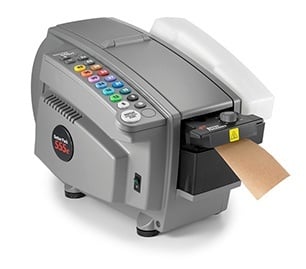How Does An Electric Water-Activated Tape Dispenser Improve Productivity?

Streamlining the packing and shipping process in your warehouse is a never-ending game of optimization. One of our most common suggestions is to make the switch from plastic, pressure-sensitive tape (PST) to water-activated tape (WAT).
If you are currently using handheld tape guns with PST to seal your cartons, you are missing out on potential productivity and safety upgrades.
Using WAT and an electric dispenser will increase both the productivity and safety of your packing station.
If you’re new to water-activated tape (also called gummed paper tape), check out our guide here.
Productivity Perk #1: Operating Electric Tape Dispensers Is Faster
Electric tape machines are extremely user-friendly.
After loading the tape and powering up the dispenser, the machine operator pushes a numbered button that corresponds to the desired length of tape. The machine wets and automatically cuts the tape to the length on the selected button. The operator then transfers the tape to the open carton, positions it, places the tape on the open flaps and presses down. The tape then bonds to the carton, providing security and strength.
Water-activated tape is made from paper, with a starch adhesive and often incorporates fiberglass reinforced strands for added strength. In order for the tape to stick to the carton, it must be “activated” with water. Electric tape machines incorporate a water heater. The heated water aids tape adhesion.
Productivity Perk #2: Electric Tape Dispensers Cut To Pre-Set Lengths
Consistency with tape length is key to keeping budgets under control and aesthetics up to customer expectations.
Rather than estimating the necessary length for each strip of tape, electric WAT dispensers allow the operator to choose from a variety of buttons with pre-set (and customizable) lengths.
Tip: To determine the length of tape required for sealing a carton, take the length of the carton and add 6 inches to provide overhang on either side of the carton for a strong seal. (For example, if your carton is 12 inches long, you would want to choose a tape length of 18 inches.)
Productivity Perk #3: Reduced Movement Required To Seal Cartons
Typically, electric tape dispensers are used in facilities to help boost productivity by reducing the number of movements a packer must make to seal a carton.
An independent research study demonstrated that carton sealing productivity is 21% higher using a WAT dispenser and WAT versus a hand-held tape gun and PST.*
Safety Perk #1: Far Less Fatigue
The reduction in movement required when an electric packaging tape dispenser is doing a large part of the work both enhances packer speed and reduces fatigue.
Safety Perk #2: Reduced Risk of Injury
Using electric tape dispensers during packaging and shipping can reduce the risk of carpal tunnel syndrome.
Carpal tunnel syndrome is a real risk when employees are using hand-held tape guns in high volume packing environments.
In fact, some of the largest e-commerce companies have switched from hand-held tape guns to WAT to eliminate the high costs of medical, hiring and training expenses associated with carpal tunnel syndrome.
How To Choose The Right Packaging Tape Dispenser
Are you interested in deciding what type of WAT dispenser is right for your company’s application?
To help you in your decision-making, click here to take a quick quiz and we’ll provide you with dispenser recommendations based upon your situation.
Speaking generally, an electric dispenser will be easier to use, increase productivity, and will offer more consistent performance. Electric dispensers do require 115 volt (220 volt for Europe, 100 volt for Japan) electric power in order to operate.
Watch the video below to see how our Better Pack 555eS Series dispenser works.
Better Packages’ WAT tape dispensing machines are sold internationally through a global certified Distributor network. Dispensers can also be purchased through a variety of industrial catalogs. Contact Us to find a variety of Authorized Sources.
* See SGS Independent Research Study
{{cta(’34c21d93-246d-4f2d-a189-701d852dc422′)}}

